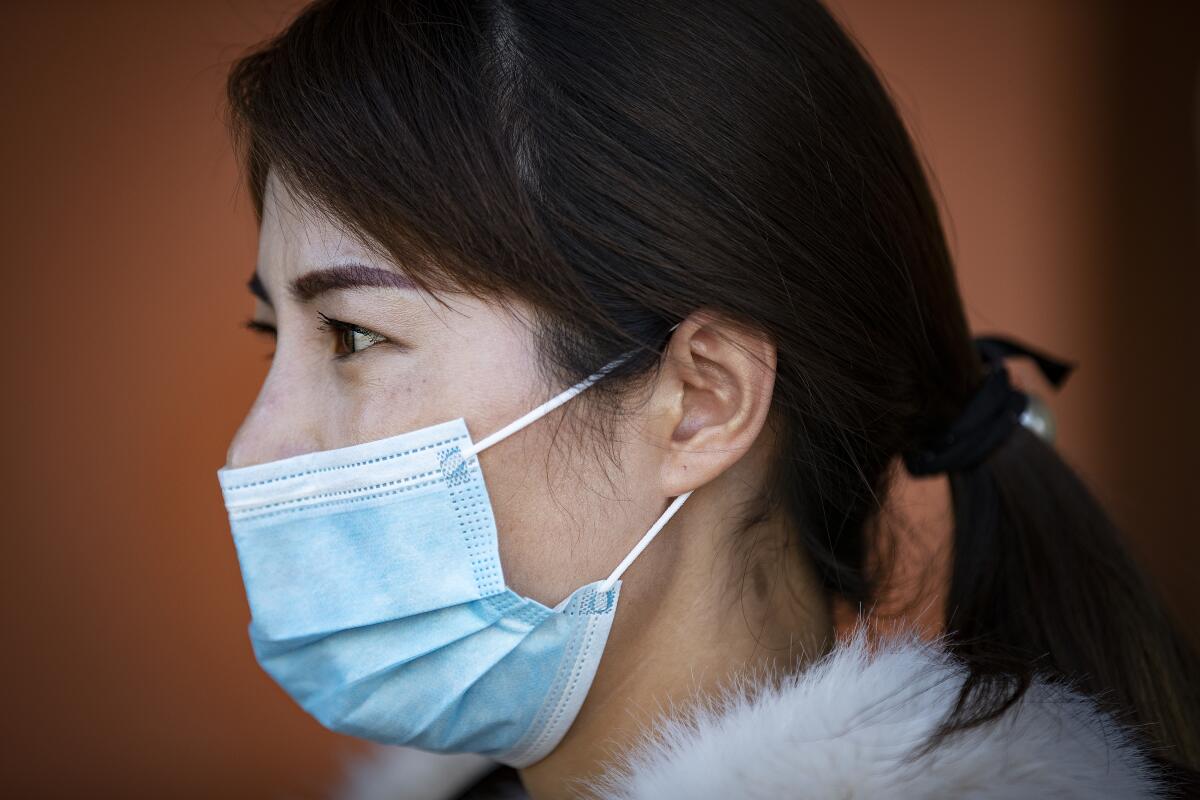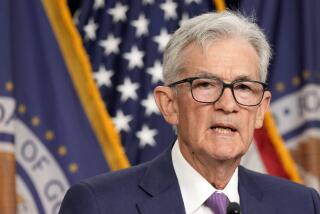Fed chief calls coronavirus threat a ‘significant’ factor in global economic outlook

- Share via
WASHINGTON — The Federal Reserve left its key interest rate intact Wednesday and indicated it was perfectly content keeping it there for the near term. But the new and rising threat from the mysterious coronavirus could very well change that calculus.
Just as other troubling economic clouds were lifting with this month’s signing of a partial U.S.-China trade deal and improving prospects in Europe, the spreading of the respiratory infection, believed to have originated in China, has already disrupted numerous companies’ operations. It’s reignited uncertainties about the outlook, which have slowed business investments and at times jolted financial markets.
Fed Chairman Jerome H. Powell, in a news conference after policymakers’ two-day meeting, told reporters that it was too early to know about the effects of the virus, but he described it as “a significant thing” with potentially widespread repercussions for the global economy.
Powell didn’t downplay the risk nor call it a likely transitory event, as some analysts were expecting.
“The Chinese economy is very important in the global economy now and, you know, when China’s economy slows down, we do feel that,” Powell said.
A broad array of U.S. and other global companies have temporarily closed down operations in China or are evacuating workers especially from Wuhan, the epicenter of the outbreak.
The pneumonia-like ailment already has sickened more than 6,000 people in China and 19 other countries or territories, with more than 130 deaths.
The Chinese government has effectively quarantined Wuhan and other cities across Hubei province in an unprecedented lockdown affecting more than 50 million people.
Honda and other car companies, and tech firms including Facebook and Microsoft, are extracting workers from China or banning their staff from China travel.
Starbucks, McDonald’s and retailers like H&M have temporarily closed many of their China outlets. And major airlines including British Airways and Lufthansa have indefinitely suspended direct flights to and from China.
Russell Johnson is the founder and president of China Array Plastics, a plastic injection-molding business. He’s been manufacturing in Wuhan since the early 1980s, first through a contractor and in more recent years at his own factory.
Several days before the Chinese New Year holiday and last Thursday’s lockdown of Wuhan, Johnson closed his factory to shield his 20 employees from possible exposure to the virus.
Since then he’s been checking in with his staff daily. “They seem pretty calm. They’re basically staying at home, playing mah-jongg and just taking it easy,” he said.
But the big question for Johnson, the Fed and everybody else is, how long will it be before the outbreak is contained and things return to normal?
“We’re just in a holding pattern,” he said Wednesday.
“If it can get resolved in weeks to a couple of months, we can weather that. But if it lasts longer than three months, then it’s going to be difficult for everybody,” he added.
Many analysts have looked for clues from an earlier China outbreak of a similar virus — severe acute respiratory syndrome outbreak, or SARS, which lasted for about six months in 2002 and 2003. There were almost 8,100 cases of SARS that resulted in 774 deaths reported in some two dozen countries.
But global air traffic today is twice as big as in the early 2000s, increasing the likelihood of potentially wider spread of the disease. China’s outbound tourists — about 16.6 million in 2002 — reached about 150 million in 2018.
SARS temporarily slowed growth in China and rippled mostly to nearby Asian countries. But as Powell suggested, China’s growth since then means its influence is far greater now.
Back in 2002, China accounted for just 8% of the global economy, on a purchasing parity basis. But it’s about 20% today, with many American and other global firms dependent on Chinese supply chains and the nation’s vast markets.
“The China virus is the 800-pound gorilla in the room when it comes to the risks that the global economy faces,” said Christopher Rupkey, managing director and chief financial economist at MUFG Union Bank in New York.
“If U.S. exports continue to fade in response to slowing world growth and trade,” he said, “the U.S. manufacturing recession could cause a real recession and bring the Federal Reserve back into the picture with rate cuts in a hurry.”
The U.S. economy grew at about 3% in 2018, slowed to around 2% last year and is likely to drop a bit further this year, according to Fed projections and many private analysts.
The recent Phase 1 trade deal between the U.S. and China could give a lift to business investment, but it’s uncertain how long the truce will last.
“Trade policy uncertainty remains elevated,” Powell said. “Businesses continue to identify it as an ongoing risk.”
Now the coronavirus injects a new element of uncertainty that could push the Fed to nudge down interest rates. The central bank cut rates three times last year after hiking them four times in 2018.
What’s more, Powell will almost certainly face pressure from President Trump to cut rates.
“Clearly Mr. Trump is using the Fed as a political football, almost on a weekly basis,” said Joe Brusuelas, chief economist at RSM US, an accounting and consulting firm.
Financial markets are now expecting a rate cut by the end of October, he said, but the Fed will be hard-pressed to make a move given the political criticisms that it will almost certainly endure in an election year.
“They want nothing to do with a rate cut or a rate hike before the election,” Brusuelas said.
More to Read
Get the L.A. Times Politics newsletter
Deeply reported insights into legislation, politics and policy from Sacramento, Washington and beyond. In your inbox twice per week.
You may occasionally receive promotional content from the Los Angeles Times.











